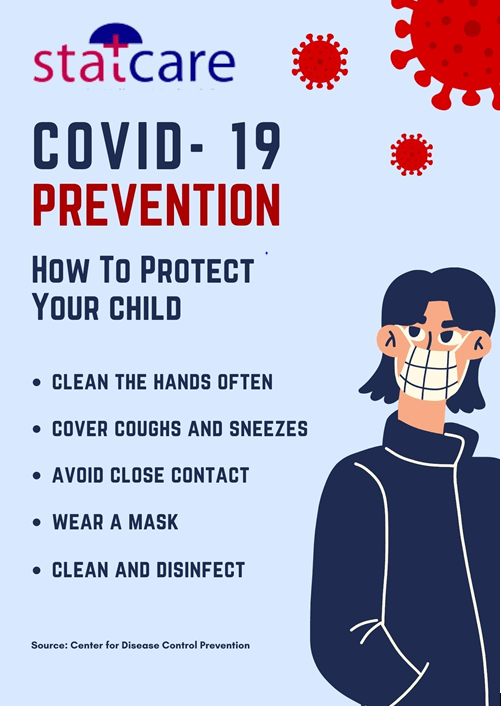Schools have reopened and in-person schooling has caused an increase in the number of children getting exposed to COVID-19. Add to that the threat of the COVID-19 Delta variant.
Pfizer-BioNTech and Moderna vaccines have been urged by the Food and Drugs Administration (FDA) to expand clinical trials for children between 5 and 11 years of age and the initial data looks promising.
However, once the vaccines are authorized for use by the FDA, it is important to consult your family doctor or pediatrician first to determine if your child is eligible to get the COVID-19 vaccine. Expect side effects to occur after vaccination. If possible, prepare the needed medication to relieve them of possible arm pain and fever.
If you think your child has COVID-19 or may have developed symptoms similar to its symptoms, it is important to get in touch with a health care professional. You may also need to have your little one undergo a COVID-19 test in the nearest Statcare clinic all over New York City. The rapid test will only take 15 minutes while the PCR test may take a few days to generate a positive or negative test result.
It has been recorded that there are fewer cases in children ages 1 to 17 years old in the United States. However, given the fact that 22% of the United States population are children, the most recent information from the Centers for Disease Control and Prevention (CDC) suggests that some COVID-19 recorded incidents of infected persons to the CDC in the US were amongst minors.
As a result, the spread and transfer of Coronavirus to and among children in the United States during the pandemic, during the spring and early summer seasons of 2020, may have been limited because of community relief measures and school closures. This could explain why children have a lower incidence than adults.
Signs and symptoms of COVID-19 in children
The COVID-19 virus seems to progress within 14 days in the same way for both infants and adults. According to CDC, here are some of the signs and symptoms of COVID-19 to watch out for your kids:
- Fever
- Fatigue
- Headache
- Myalgia
- Cough
- Nasal congestion or rhinorrhea
- New loss of taste or smell
- Sore throat
- Shortness of breath or difficulty breathing
- Abdominal pain
- Diarrhea
- Nausea or vomiting
- Poor appetite or poor feeding
These symptoms can be experienced by children who are infected by COVID-19, a few respiratory symptoms or gastrointestinal symptoms, or sometimes they can be asymptomatic (they might have the virus but do not experience any COVID-19 symptom from the list above). Cough and/or fever are the most typical signs seen in children.
According to John Hopkins Medicine, if a child tested positive with COVID-19, he or she is less likely to develop severe sickness, unlike adults. Although some children may be at higher risk for serious COVID-19 infection, here are some risk factors to look at for children with the virus:
- Children under 2 years old
- Black, Indigenous, and People of Color (BIPOC) who experience health disparities and displacement
- Pre-matured children (a birth that took place 3 weeks before the expected date)
- Children who are suffering from lung complications and other comorbidities (asthma and diabetes)
NOTE: In the event that your child struggles to breathe, you must call 911 immediately.
In some cases, doctors from the U.K. and U.S have found that after the COVID-19 infection, patients aged 2-15 years old can develop a condition called Multisystem Inflammatory Syndrome (MIS-C). If this happens, get in touch with your pediatrician right away when your child experiences a fever of 100.4 Fahrenheit or higher for more than a day. Parents should also take note of the following symptoms:
- Odd weariness and fatigue
- Red rash
- Belly pain
- Vomiting and diarrhea
- Cracked lips (red)
- Flush eyes
- Inflamed hands or feet
How to protect your child?
For children who are not yet eligible to be vaccinated against COVID-19, the best approach to keep them from getting infected is to keep them away from people who are (or may be) infected with the virus. This goes for family members as well. Here are four of the most effective methods for keeping your children healthy:
- Outside of the home, observe social distancing.
- Avoid crowded places or indoor areas where there is not enough ventilation.
- Monitor your kid’s school or daycare to ensure safety protocols are being observed.
- Avoid physical contact with other children and always make sure that your child is always wearing a mask.
- Avoid close contact with adults and other children with immunocompromised conditions or those who are vulnerable because of pre-existing conditions.
- Teach them to stay 6 feet away from other people, whether those individuals are fully vaccinated or not.
- Clean and disinfect your house as often as possible.
- If arriving home from outdoors, change your child’s clothes immediately and give them a quick shower or bath. This way, any bacteria or virus that might have stuck to them and their clothes can be eliminated.
Here are some recommendations from CDC:











